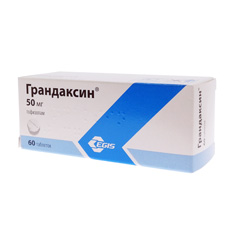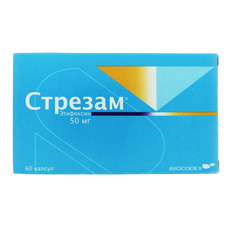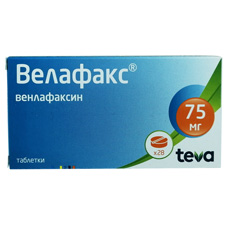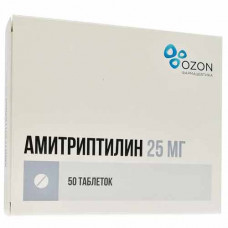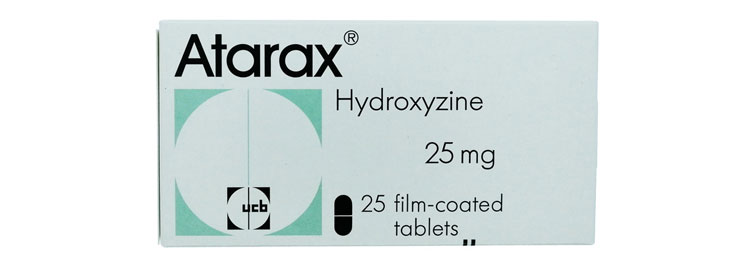
Atarax®
Atatarax is effective for treatment of anxiety in adults, psychomotor agitation, feelings of internal tension, increased irritability.
Pharmachologic effect:
AnxiolyticPharmacodynamics:
Hydroxyzine blocks H1-histamine receptors, has antimuscarinic and sedative effects, and contributes to the inhibition of the activity of some subcortical zones.
In addition to H1-histamine blocking, it has a bronchodilatory and antiemetic effect, has a moderate inhibitory effect on gastric secretion. Hydroxyzine significantly reduces itching in patients with urticaria, eczema, and dermatitis.
Hydroxyzine improves cognitive functions, including attention and memory. Does not cause addiction, psychological dependence and withdrawal syndrome with prolonged use.
Pharmacokinetics:
After oral administration, absorption is high, the Tmax value is 2 hours. After taking an average dose of 50 mg, Cmax in adults is 70 ng / ml.
After intramuscular administration of a single dose of 50 mg Cmax is 65 ng / ml.
Hydroxyzine is more concentrated in tissues than in plasma. The Vd value is 7–16 l/kg in adults. Hydroxyzine crosses the BBB and the placenta, concentrating more in fetal than maternal tissues.
Hydroxyzine penetrates well into the skin, while the concentration of hydroxyzine in the skin is much higher than the concentration in the blood serum, both after a single and after repeated use.
Hydroxyzine is metabolized in the liver. Cetirizine - the main metabolite (45%) - is a blocker of H1-histamine receptors. Metabolites are found in breast milk.
T1/2 in adults - 14 hours (range - 7-20 hours). The total clearance of hydroxyzine is 13 ml/min/kg. About 0.8% of hydroxyzine is excreted unchanged through the kidneys. Cetirizine is excreted mainly in the urine, also unchanged (25% of the oral dose or 16% of the IM dose of hydroxyzine).
Indications:
Symptomatic treatment of anxiety in adults, psychomotor agitation, feelings of internal tension, increased irritability in neurological (generalized anxiety and impaired adaptation) and somatic diseases; withdrawal alcohol syndrome; premedication and postoperative period (as part of combination therapy); itching of allergic origin (symptomatic therapy).
Contraindications:
Hypersensitivity to hydroxyzine and cetirizine, aminophylline or ethylenediamine; porphyria; pregnancy; the period of labor activity; lactation; age up to 1 year (when administered intramuscularly) or 3 years (when taken orally).
Use with caution:
myasthenia; prostatic hyperplasia with clinical manifestations (including difficulty urinating); glaucoma; dementia; convulsive disorders, including epilepsy; tendency to arrhythmia, including electrolyte imbalance (hypokalemia, hypomagnesemia); prolongation of the QT interval and / or a history of cardiovascular disease (including heart failure, arterial hypertension); the use of drugs that can cause arrhythmia; hyperthyroidism.
Pregnancy and breast-feeding:
Contraindicated during pregnancy and during childbirth.
At the time of treatment, breastfeeding should be stopped (metabolites are excreted into breast milk).
Side effects:
Possible side effects are listed below by body system and frequency of occurrence:
very often (≥1/10) : drowsiness;
often (≥1/100, <1/10) : headache, fatigue;
infrequently (≥1/1000, <1/100): dizziness, insomnia, tremor, agitation, confusion, nausea;
rarely (≥1/10000, <1/1000): hypersensitivity, convulsions, dyskinesia, hallucinations, disorientation, disturbance of accommodation, visual impairment, tachycardia, decrease in blood pressure, vomiting, constipation, impaired liver function tests, urinary retention, pruritus, rash (erythematous, maculopapular), urticaria, dermatitis, hyperthermia, malaise;
very rarely (<1/10000): anaphylactic shock, bronchospasm, angioedema, increased sweating, acute generalized exanthematous-pustular rash, erythema multiforme, Stevens-Johnson syndrome.
Interaction:
It is necessary to take into account the potentiating effect of hydroxyzine when used together with drugs that depress the central nervous system, such as narcotic analgesics, barbiturates, anxiolytics, hypnotics, alcohol. In this case, their doses should be selected individually.
Simultaneous use with MAO inhibitors and anticholinergics should be avoided.
Hydroxyzine interferes with the pressor action of epinephrine and the anticonvulsant activity of phenytoin, as well as the action of betahistine and drugs - cholinesterase inhibitors.
It has been established that the use of cimetidine at a dose of 600 mg twice a day increases the concentration of hydroxyzine in serum by 36% and reduces the Cmax of the cetirizine metabolite by 20%.
The effect of atropine, belladonna alkaloids, cardiac glycosides, antihypertensive drugs, H2-histamine receptor blockers does not change under the action of hydroxyzine.
Hydroxyzine is an inhibitor of the CYP2D6 isoenzyme and in high doses may cause interaction with CYP2D6 substrates. Since hydroxyzine is metabolized in the liver, an increase in its plasma concentration can be expected when used simultaneously with inhibitors of microsomal liver enzymes. Since hydroxyzine is metabolized by alcohol dehydrogenase and the CYP3A4 / 5 isoenzyme, it is possible to increase the concentration of hydroxyzine in plasma when used simultaneously with drugs that potentially inhibit the CYP3A4 / 5 isoenzyme (telithromycin, clarithromycin, delavirdine, styripentol, ketoconazole, voriconazole, itraconazole, posaconazole and some HIV protease inhibitors including atazanavir, indinavir, nelfinavir, ritonavir, saquinavir, lopinavir/ritonavir, saquinavir/ritonavir, and tipranavir/ritonavir).
The simultaneous use of hydroxyzine with drugs that can potentially cause arrhythmias may increase the risk of prolongation of the QT interval and the occurrence of ventricular tachycardia of the "pirouette" type.
The use of hydroxyzine concomitantly with ototoxic agents such as gentamicin may mask symptoms of ototoxicity such as dizziness.
Hydroxyzine should be canceled 5 days before the planned skin test with allergens.
Dosing and Administration:
Atarax is taken orally.
Adults: in general practice - 25-100 mg / day in divided doses, in psychiatry - up to 300 mg / day. The usual duration of treatment is 4 weeks. In anesthesiology: intramuscularly, adults - 100-200 mg / day, for premedication - 50-200 mg.
Children are prescribed depending on age and body weight.
Overdose:
Symptoms include nausea, vomiting, tachycardia, pyrexia, drowsiness, impaired pupillary reflex, tremor, confusion or hallucinations. Subsequently, depression of consciousness, respiration, convulsions, a decrease in blood pressure, and arrhythmia may develop. Possible aggravation of coma and cardiopulmonary collapse.
Treatment: In the case of oral administration, gastric lavage followed by endotracheal intubation. Activated charcoal may be used, but there is insufficient evidence to support its effectiveness. It is necessary to control the state of the state of respiration and blood circulation using ECG monitoring, ensure adequate oxygenation, introduce naloxone, dextrose (glucose) and thiamine; if it is necessary to obtain a vasopressor effect, norepinephrine or metaraminol is prescribed, epinephrine should not be used. Cardiac activity and blood pressure should be monitored within 24 hours after the disappearance of symptoms.
At high doses, hydroxyzine can lead to QT prolongation and overt ECG changes.
The use of analeptics is unacceptable.
There is no specific antidote. Hemodialysis is ineffective.
Special instructions:
In renal and / or hepatic insufficiency, doses should be reduced.
In the elderly, the dosage should be selected individually, starting with half the minimum dose and adjusting in the range of recommended doses.
During treatment with Atarax, alcohol should be avoided.
Atarax®
in Cyrillic : Атаракс
SUBSTANCE
Hydroxyzine
DOSAGE FORM
25mg x 25 tabs


